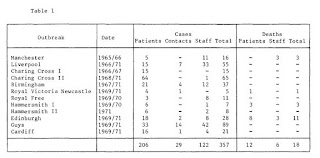Staff as well as patients die, and new patients are turned down in affected centres
From about 1964 there was increasing excitement that dialysis might become a major life-saving treatment for chronic renal failure, not just for acute renal failure. Transplantation was also in its infancy, but despite some promise, overall success rates at this time were very poor. A major frustration was the lack of resources to give dialysis to all who could benefit. Some remarkably bold approaches included self-dialysis and home dialysis, for reasons of space and economy as well as patient independence.
A notorious anonymous editorial in the Lancet in November 1965 railed against the expansion of dialysis, complaining that it was consuming resources and diverting the attention of nephrologists who ought to be spending time on developing transplantation and blood pressure treatments. In the following three weeks, 5 pages of letters of protest were published from the renal units at Charing Cross, Edinburgh, Exeter, Leeds, Newcastle and the Royal Free, and from patient and medical student Robin Eady from Guy’s.
 |
| Hepatitis outbreaks in the UK, 1964-71 (Marmion 1982) |
One paragraph of the gloomy editorial mentioned a recent serious outbreak of hepatitis at Manchester Royal Infirmary which had already affected over 50 people, and killed a nurse and a hospital porter. It later extended to 14 members of staff, with a further death. “Clearly the risk of similar outbreaks in other dialysis centres cannot be discounted”. This turned out to be the article’s only accurate premonition.
This Manchester outbreak was just the beginning, similar outbreaks affecting multiple units in the UK and worldwide. Edinburgh had one of the worst experiences with a particularly high mortality. The outbreak began when a patient was given a blood transfusion from a donor who was incubating hepatitis. In just over a year from June 1969, 26 dialysis patients were affected and 7 died. 12 members of staff developed hepatitis, of whom 4 died, two transplant surgeons and two technicians. Renal units now caused fear not only because of the complexity of their diseases and treatments.
The ‘Australia antigen’ was linked to serum hepatitis in 1966, leading to the identification of hepatitis B, and testing became widely available in 1969. It became apparent how extraordinarily easy it was to transmit hepatitis B. The Rosenheim Report in 1972 made recommendations about prevention, and coincided with a decline in new cases and the end of outbreaks. However in the same year the European Renal Registry recorded that 499 members of staff contracted hepatitis across 568 reporting renal units in Europe, with 12 deaths (2.4%).
Further expansion of dialysis slowed markedly, and in some units no new patients were taken on for a prolonged period. In many centres, and notably in the UK, there was a strong move towards home treatments delivered by patients. Vaccination against hepatitis B only became available from 1979 and was widely implemented in the 1980s. Newcomers sometimes wonder why current protocols for hepatitis testing remain so strict given the availability of vaccination, but history makes this clear.
In Edinburgh, the experience was so powerful that the full story was not presented at an internal meeting for 35 years. The memories of carrying out exchange transfusions on a dying surgical colleague in his own unit are indelibly imprinted on the minds of those involved. At the time it was not clear who would develop the disease next or when the epidemic would end.
 The 1975 novel by Colin Douglas ‘The Houseman’s Tale’ is an outrageous, sexist, darkly funny and eventually moving novel of junior doctor life with the epidemic of hepatitis in the background. It was written by a doctor who was a senior student and house physician in Edinburgh at the time of the outbreak. Essential reading for renal unit staff; out of print but second hand copies can be found online.
The 1975 novel by Colin Douglas ‘The Houseman’s Tale’ is an outrageous, sexist, darkly funny and eventually moving novel of junior doctor life with the epidemic of hepatitis in the background. It was written by a doctor who was a senior student and house physician in Edinburgh at the time of the outbreak. Essential reading for renal unit staff; out of print but second hand copies can be found online.
Further info:
Cameron JS 2002. A History of the Treatment of Renal Failure by Dialysis (OUP)
Editorial. Hepatitis and the artificial kidney. Lancet 1965 ii 1000
Editorial. Hepatitis in dialysis units. Br Med J 1970 iv 255-6
Editorial. Profit and loss in intermittent haemodialysis. Lancet 1965 ii 1058-9; responses 1182-4, 1245-7
Marmion et al 1982. Dialysis-associated hepatitis in Edinburgh; 1969-78. Rev Infect Dis 4:619-37
Baruch Blumberg was awarded the Nobel Prize for his work on Hepatitis B in 1976. Biography on the Nobel Prize site.